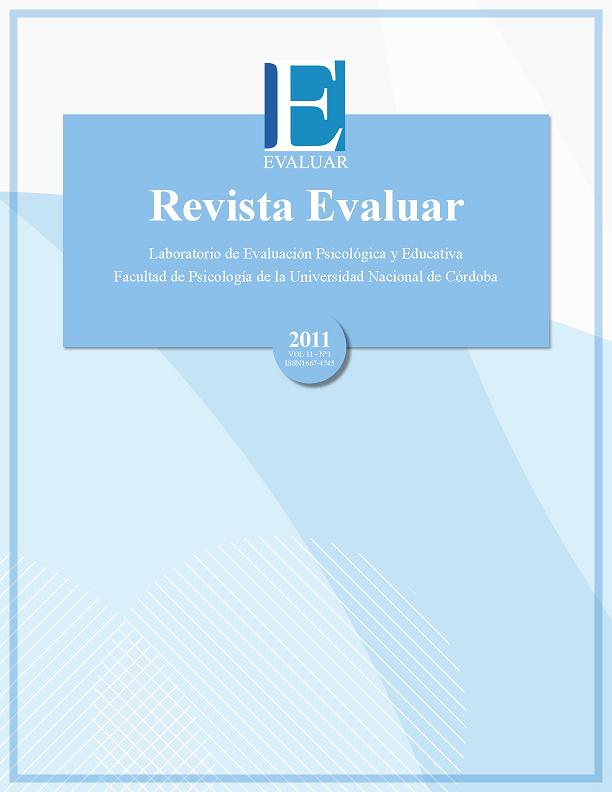Estudios Psicométricos del Self-Directed Search (Forma E) en una muestra de estudiantes Argentinos.
DOI:
https://doi.org/10.35670/1667-4545.v11.n1.2841Keywords:
Self-Directed Search, intereses vocacionales, adolescentes, confiabilidad, validezAbstract
In the present study was undertaken aimed at assessing the psychometric properties of the Activities section (E) of the Self-Directed Search (SDS-E). To meet this goal were administered the SDS-E and Career Intentions Questionnaire to 340 students last year of middle school (Polimodal) of the city of Cordoba. Then the following studies were conducted: item analysis, exploratory factor analysis, reliability, and predictive validity of choice goals. The results show how a 6-factor solution is viable for our population. The internal consistency of the six factors was appropriate. Studies were conducted predictive validity in relation to the intention of choice runs. In the latter study, between 22% to 40% of the career goal choice variance is explained by the independent variables. Overall, the results are encouraging and can be considered an acceptable option to measure professional interests.
Downloads
References
Aiken, A. (2003). Tests psicológicos y evaluación. México: Prentice Hall.
American College Testing. (1995). Technical manual: Revised unisex edition of the ACT Interest Inventory (UNIACT). Iowa City, IA: ACT Inc.
Amstrong, I., Allison, W., & Rounds, J. (2008). Development and initial validation of brief public domain RIASEC marker scales. Journal of Vocational Behavior 73, 287–299.
Assessment Resources.Holland, J. (1994). Self-Directed Search. Manual. Psychological Assessment Resources: Odessa, FL.
Campbell, D. P., Hyne, S. A., & Nilsen, D. L. (1992). Manual for the Campbell Interest and Skills Inventory. Minneapolis, MN: National Computer Systems.
Ferrando, P. J. (1996). Evaluación de la unidimensionalidad de los ítems mediante análisis factorial. [Versión electrónica]. Psicothema, 8, nº 2, 397-410.
Glutting, J.(2002). Some psychometric properties of a system to measure ADHD among college students. Measurement and Evaluation in Counseling and Development. 34, 194-209.
Harmon, L. W., Hansen, J. I. C., Borgen, F. H., & Hammer, A. L. (1994). Strong Interest Inventory: Applications and technical guide. Palo Alto, CA: Consulting Psychologists.
Holland, J. (1997). Making Vocational Choices: A theory of vocational personalities and work environments (third edition). Odessa, Fl: Psychological Assessment Resources.
Holland, J. L. (1985). Professional manual for the Self-Directed Search. Odessa FL: Psychological Assessment Resources.
Holland, J. L. (1992). Making vocational choices: a theory of vocational personalities and work environments, 2ª ed. Odessa, FL: Psychological.
Holland, J. L. (1997). Making vocational choices: a theory of vocational personalities and work environments, 3ª ed. Odessa, FL: Psychological Assessment Resources.
Kuder, F., & Zytowski, D. G. (1991). Kuder Occupational Interest Survey Form DD general manual. Adel, IA: National Career Asssessment Associates.
Lorenzo-Seva, U., & Ferrando, P. J. (2006). FACTOR: A computer program to fit the exploratory factor analysis model. Behavioral Research Methods, Instruments and Computers, 38(1), 88-91.
Martínez Vicente, J. & Valls Fernández, F. (2006). La elección vocacional y la planificación de la carrera. Adaptación española del Self-Directed Search (SDS-R) de Holland.Psicothema, 117-122.
Nunnally, J. y Bernstein, I. (1995). Teoría Psicométrica. México: Mc Graw Hill.
Pérez, E. (2001). Construcción de un Inventario de Autoeficacia para Inteligencias Múltiples. Tesis Doctoral. Inédita. Facultad de Psicología. Universidad Nacional de Córdoba.
Rounds, J. (1995). Vocational interests: Evaluation of structural hypotheses. In D. Lubinski & R. V. Dawis (Eds.), Assessing individual differences in human behavior: New concepts, methods, and findings (pp. 177–232). Palo Alto, CA: Consulting Psychologists Press.
Schraw, G., & Lehman, S. (2001). Situational interest: A review of the literature and directions for future research. Educational Psychology Review, 13(1), 23-52.
Tabachnick, B. & Fidell, L. (2001). Using multivariate statistics (4º ed). Boston: Allyn and Bacon. Thompson, B. (2002). Exploratory and confirmatory factor analisis. Washington, DC: American Psychological Association.
Velandrino, A. (1998). Análisis de datos en ciencias sociales. Murcia: DM Editora.
Young, F. W. (1996). ViSta: Developing Statistical Objects. The Visual Statistic project, Thurstone Psychometric Lab, Univ. N. Carolina, Chapel Hill, Research Memorandum Number 1996-1.
Downloads
Published
Issue
Section
License
Copyright (c) 2011 Marcos Cupani, Ivana Saurina

This work is licensed under a Creative Commons Attribution 4.0 International License.
Revista Evaluar aplica la Licencia Internacional de Atribuciones Comunes Creativas (Creative Commons Attribution License, CCAL). Bajo esta licencia, los autores retienen la propiedad de copyright de los artículos pero permiten que, sin que medie permiso de autor o editor, cualquier persona descargue y distribuya los artículos publicados en Evaluar. La única condición es que siempre y en todos los casos se cite a los autores y a la fuente original de publicación (i.e. Evaluar). El envío de artículos a Evaluar y la lectura de los mismos es totalmente gratuito.



